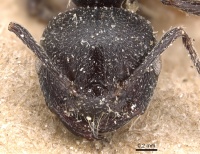Crematogaster peringueyi
| Crematogaster peringueyi | |
|---|---|

| |
| Scientific classification | |
| Kingdom: | Animalia |
| Phylum: | Arthropoda |
| Class: | Insecta |
| Order: | Hymenoptera |
| Family: | Formicidae |
| Subfamily: | Myrmicinae |
| Tribe: | Crematogastrini |
| Genus: | Crematogaster |
| Species: | C. peringueyi |
| Binomial name | |
| Crematogaster peringueyi Emery, 1895 | |
| Subspecies | |
| |
Specimen records show C. peringueyi nests in cavities in dead wood, either on the ground or in standing vegetation. They also construct carton nests. These can be arboreal, on and under the ground, and in wood cavities. Collections have been made from vegetation, from nests inside wood cavities that are broken into, from readily visible carton nest sturctures, in litter samples, and in pitfall traps.
Identification
Distribution
Latitudinal Distribution Pattern
Latitudinal Range: -12.473° to -34.82550167°.
| North Temperate |
North Subtropical |
Tropical | South Subtropical |
South Temperate |
- Source: AntMaps
Distribution based on Regional Taxon Lists
Afrotropical Region: Namibia, South Africa (type locality).
Distribution based on AntMaps
Distribution based on AntWeb specimens
Check data from AntWeb
Countries Occupied
| Number of countries occupied by this species based on AntWiki Regional Taxon Lists. In general, fewer countries occupied indicates a narrower range, while more countries indicates a more widespread species. |

|
Estimated Abundance
| Relative abundance based on number of AntMaps records per species (this species within the purple bar). Fewer records (to the left) indicates a less abundant/encountered species while more records (to the right) indicates more abundant/encountered species. |

|
Biology
Castes
Nomenclature
The following information is derived from Barry Bolton's Online Catalogue of the Ants of the World.
- peringueyi. Crematogaster peringueyi Emery, 1895h: 27, figs. 16, 17 (w.q.m.) SOUTH AFRICA.
- Type-material: syntype workers, syntype queens, syntype males (numbers not stated).
- Type-locality: South Africa: Cape Town, i.-iv.1893 (E. Simon).
- Type-depository: MSNG.
- Combination in C. (Crematogaster): Wheeler, W.M. 1922a: 842;
- combination in C. (Acrocoelia): Emery, 1922e: 148;
- combination in C. (Crematogaster): Bolton, 1995b: 166.
- Status as species: Forel, 1910f: 7; Forel, 1913j: 213; Arnold, 1920a: 509; Emery, 1922e: 148; Wheeler, W.M. 1922a: 842; Stitz, 1923: 155; Bolton, 1995b: 159.
- Distribution: Namibia, South Africa.
- Current subspecies: nominal plus angustior, cacochyma, caculata, dentulata, gedeon.
Unless otherwise noted the text for the remainder of this section is reported from the publication that includes the original description.
Description
References
- Devenish, A.J.M., Newton, R.J., Bridle, J.R., Gomez, C., Midgley, J.J., Sumner, S. 2021. Contrasting responses of native ant communities to invasion by an ant invader, Linepithema humile. Biological Invasions 23, 2553–2571 (doi:10.1007/s10530-021-02522-7).
- Emery, C. 1895i. Voyage de M. E. Simon dans l'Afrique australe (janvier-avril 1893). 3e mémoire. Formicides. Ann. Soc. Entomol. Fr. 64:15-56. (page 27, figs. 16, 17 worker, queen, male described)
- Emery, C. 1922c. Hymenoptera. Fam. Formicidae. Subfam. Myrmicinae. [part]. Genera Insectorum 174B: 95-206 (page 148, Combination in C. (Acrocoelia))
- Wheeler, W. M. 1922j. Ants of the American Museum Congo expedition. A contribution to the myrmecology of Africa. VIII. A synonymic list of the ants of the Ethiopian region. Bull. Am. Mus. Nat. Hist. 45: 711-1004 (page 842, Combination in C. (Crematogaster))
References based on Global Ant Biodiversity Informatics
- Addison P., and M. J. Samways. 2000. A survey of ants (Hymenoptera: Formicidae) that forage in vineyards in the Western Cape Province, South Africa
- Arnold G. 1920. A monograph of the Formicidae of South Africa. Part IV. Myrmicinae. Annals of the South African Museum. 14: 403-578.
- Emery C. 1895. Voyage de M. E. Simon dans l'Afrique australe (janvier-avril 1893). 3e mémoire. Formicides. Annales de la Société Entomologique de France 64: 15-56.
- Forel A. 1910. Zoologische und anthropologische Ergebnisse einer Forschungsreise im westlichen und zentralen Südafrika ausgeführt in den Jahren 1903-1905 von Dr. Leonhard Schultze. Vierter Band. Systematik und Tiergeographie. D) Formicidae. Denkschriften der Medizinisch-Naturwissenschaftlichen Gesellschaft zu Jena 16: 1-30.
- Forel, A.. "Ameisen aus Rhodesia, Kapland usw. (Hym.) gesammelt von Herrn G. Arnold, Dr. H. Brauns und Anderen." Deutsche Entomologische Zeitschrift 1913(Suppl.) (1913): 203-225.
- Koen J. H., and W. Breytenbach. 1988. Ant species richness of fynbos and forest ecosystems in the Southern Cape. South Afr. Tydskr. Dierk. 23(3): 184-188.
- Lach, L. 2008. Argentine ants displace floral arthropods in a biodiversity hotspot. Diversity and Distributions 14:281-290
- Stitz H. 1923. Hymenoptera, VII. Formicidae. Beiträge zur Kenntnis der Land- und Süsswasserfauna Deutsch-Südwestafrikas 2: 143-167.
- Wheeler W. M. 1922. Ants of the American Museum Congo expedition. A contribution to the myrmecology of Africa. VIII. A synonymic list of the ants of the Ethiopian region. Bulletin of the American Museum of Natural History 45: 711-1004



